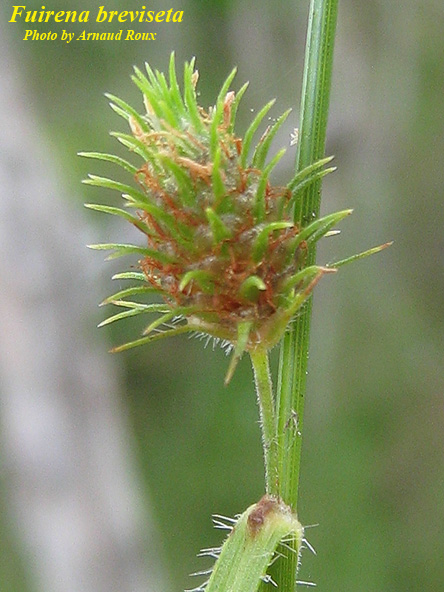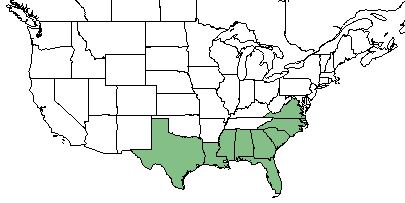Difference between revisions of "Fuirena breviseta"
Rwagner914 (talk | contribs) (Created page with "{{subst:Template:PlantName}}") |
HaleighJoM (talk | contribs) (→Ecology) |
||
| (25 intermediate revisions by 7 users not shown) | |||
| Line 1: | Line 1: | ||
{{italic title}} | {{italic title}} | ||
| + | Common Names: saltmarsh umbrella-sedge <ref name= "USDA"> [https://plants.usda.gov/core/profile?symbol=CEAM USDA Plant Database]</ref>; short-bristled umbrella-sedge | ||
<!-- Get the taxonomy information from the NRCS Plants database --> | <!-- Get the taxonomy information from the NRCS Plants database --> | ||
{{taxobox | {{taxobox | ||
| − | | name = | + | | name = Fuirena breviseta |
| − | | image = | + | | image = Fuirena_breviseta_AFP.jpg |
| − | | image_caption = Photo by | + | | image_caption = Photo by the [http://florida.plantatlas.usf.edu/photo.aspx?ID=14827 Atlas of Florida Plants Database] |
| regnum = Plantae | | regnum = Plantae | ||
| divisio = Magnoliophyta - Flowering plants | | divisio = Magnoliophyta - Flowering plants | ||
| − | | classis = Liliopsida - Moncots | + | | classis = Liliopsida - Moncots |
| − | | ordo = | + | | ordo = Poales |
| − | | familia = | + | | familia = Cyperaceae |
| − | | genus = '' | + | | genus = ''Fuirena'' |
| − | | species = ''''' | + | | species = '''''F. breviseta''''' |
| − | | binomial = '' | + | | binomial = ''Fuirena breviseta'' |
| − | | binomial_authority = | + | | binomial_authority = Coville |
| − | | range_map = | + | | range_map = FUIR_BREV_DIST.JPG |
| − | | range_map_caption = Natural range of '' | + | | range_map_caption = Natural range of ''Fuirena breviseta'' from USDA NRCS [https://plants.usda.gov/core/profile?symbol=FUBR Plants Database]. |
}} | }} | ||
==Taxonomic Notes== | ==Taxonomic Notes== | ||
| − | ==Description== | + | Synonyms: ''F. squarrosa'' Michaux.<ref name="weakley">Weakley, A.S. 2015. Flora of the southern and mid-atlantic states. Working Draft of 21 May 2015. University of North Carolina at Chapel Hill, Chapel Hill, North Carolina.</ref> |
| − | <!-- Basic life history facts such as annual/perrenial, monoecious/dioecious, root morphology, seed type, etc. --> | + | |
| + | Varieties: none.<ref name="weakley">Weakley, A.S. 2015. Flora of the southern and mid-atlantic states. Working Draft of 21 May 2015. University of North Carolina at Chapel Hill, Chapel Hill, North Carolina.</ref> | ||
| + | |||
| + | ==Description== <!-- Basic life history facts such as annual/perrenial, monoecious/dioecious, root morphology, seed type, etc. --> | ||
| + | ''F. breviseta'' is a perennial graminoid of the Cyperaceae family that is native to North America.<ref name= "USDA"> [https://plants.usda.gov/core/profile?symbol=CEAM USDA Plant Database]</ref> It can reach heights up to 3 feet tall with bloom color ranging from yellow to green and to brown.<ref>[[https://www.wildflower.org/plants/search.php?search_field=&newsearch=true]] Lady Bird Johnson Wildflower Center. Accessed: May 13, 2019</ref> | ||
| + | |||
==Distribution== | ==Distribution== | ||
| + | ''F. breviseta'' is found in Florida, Georgia, South Carolina, North Carolina, Alabama, Mississippi, Louisiana, and Texas. <ref name= "USDA"> [https://plants.usda.gov/core/profile?symbol=CEAM USDA Plant Database]</ref> This plant is a southeastern coastal plain endemic species.<ref name= "Weakley"/> | ||
| + | |||
==Ecology== | ==Ecology== | ||
===Habitat=== <!--Natural communities, human disturbed habitats, topography, hydrology, soils, light, fire regime requirements for removal of competition, etc.--> | ===Habitat=== <!--Natural communities, human disturbed habitats, topography, hydrology, soils, light, fire regime requirements for removal of competition, etc.--> | ||
| − | < | + | Common habitats for ''F. breviseta'' is Carolina bays, savannas, ditches, and other wetlands. <ref name= "Weakley"> Weakley, A. S. (2015). Flora of the Southern and Mid-Atlantic States. Chapel Hill, NC, University of North Carolina Herbarium.</ref> Habitats of specimens collected include drying loamy sands of a ditch, wet sand on edge of a dike, pond pargin in shallow water, on edge of pine plantation, on border of wakulla river, wet pine flatwoods, and on edge of a lake. <ref name = "FSU herbarium"> URL: http://herbarium.bio.fsu.edu. Last accessed: June 2018. Collectors: Loran Anderson, Travis MacClendon, Karen MacClendon, R.K.Godfrey, R.F. Doren, Cecil Slaughter, William Platt, Garret Crow, Walker Judd. States and counties: Florida (Jefferson, Wakulla, Liberty, Calhoun, Jackson, Dixie, Washington, Marion, Duval, Osceola, Gadsden, Nassau, Alachua, Gulf), Georgia (Thomas)</ref> This species is listed by the USDA Natural Resources Conservation Service as an obligate wetland species that is only found in wetland habitats.<ref name= "USDA"/> It is also a characteristic species of the calcareous savannas in Florida.<ref name= "Carr">Carr, S. C., et al. (2010). "A Vegetation Classification of Fire-Dependent Pinelands of Florida." Castanea 75(2): 153-189.</ref> |
| + | |||
| + | Associated species include ''Eleocharis'' sp., ''Rhynchospora'' sp., ''Scleria'' sp., ''Mecardonia'' sp., ''Carex'' sp., and ''Juncus'' sp.<ref name= "FSU herbarium"/> | ||
| + | |||
| + | ''Fuirena breviseta'' is frequent and abundant in the Calcareous Savannas community type as described in Carr et al. (2010).<ref>Carr, S.C., K.M. Robertson, and R.K. Peet. 2010. A vegetation classification of fire-dependent pinelands of Florida. Castanea 75:153-189.</ref> | ||
| + | |||
| + | ===Phenology=== | ||
| + | Generally, ''F. breviseta'' flowers from July until October.<ref name= "Weakley"/> It has been observed flowering in September, October, and November. <ref name= "Pan Flora"> Nelson, G. PanFlora: Plant data for the eastern United States with emphasis on the Southeastern Coastal Plains, Florida, and the Florida Panhandle. www.gilnelson.com/PanFlora/ Accessed: 21 MAY 2018</ref> | ||
<!--===Seed dispersal===--> | <!--===Seed dispersal===--> | ||
<!--===Seed bank and germination===--> | <!--===Seed bank and germination===--> | ||
| − | + | ===Fire ecology=== <!--Fire tolerance, fire dependence, adaptive fire responses--> | |
| + | This species grows in habitats that are fire-dependent.<ref name= "Carr"/> | ||
<!--===Pollination===--> | <!--===Pollination===--> | ||
| − | <!--=== | + | <!--===Herbivory and toxicology===--> |
| − | <!--==Diseases and parasites==--> | + | <!--===Diseases and parasites===--> |
| − | ==Conservation and | + | ==Conservation, cultivation, and restoration== |
| + | This species is vulnerable in Georgia and Mississippi, critically imperiled in Arkansas, and possibly extirpated in Virginia.<ref>[[http://explorer.natureserve.org]] NatureServe Explorer. Accessed: May 13, 2019</ref> | ||
| − | == | + | ==Cultural use== |
==Photo Gallery== | ==Photo Gallery== | ||
<gallery widths=180px> | <gallery widths=180px> | ||
</gallery> | </gallery> | ||
==References and notes== | ==References and notes== | ||
Latest revision as of 19:50, 30 June 2022
Common Names: saltmarsh umbrella-sedge [1]; short-bristled umbrella-sedge
| Fuirena breviseta | |
|---|---|

| |
| Photo by the Atlas of Florida Plants Database | |
| Scientific classification | |
| Kingdom: | Plantae |
| Division: | Magnoliophyta - Flowering plants |
| Class: | Liliopsida - Moncots |
| Order: | Poales |
| Family: | Cyperaceae |
| Genus: | Fuirena |
| Species: | F. breviseta |
| Binomial name | |
| Fuirena breviseta Coville | |

| |
| Natural range of Fuirena breviseta from USDA NRCS Plants Database. | |
Contents
[hide]Taxonomic Notes
Synonyms: F. squarrosa Michaux.[2]
Varieties: none.[2]
Description
F. breviseta is a perennial graminoid of the Cyperaceae family that is native to North America.[1] It can reach heights up to 3 feet tall with bloom color ranging from yellow to green and to brown.[3]
Distribution
F. breviseta is found in Florida, Georgia, South Carolina, North Carolina, Alabama, Mississippi, Louisiana, and Texas. [1] This plant is a southeastern coastal plain endemic species.[4]
Ecology
Habitat
Common habitats for F. breviseta is Carolina bays, savannas, ditches, and other wetlands. [4] Habitats of specimens collected include drying loamy sands of a ditch, wet sand on edge of a dike, pond pargin in shallow water, on edge of pine plantation, on border of wakulla river, wet pine flatwoods, and on edge of a lake. [5] This species is listed by the USDA Natural Resources Conservation Service as an obligate wetland species that is only found in wetland habitats.[1] It is also a characteristic species of the calcareous savannas in Florida.[6]
Associated species include Eleocharis sp., Rhynchospora sp., Scleria sp., Mecardonia sp., Carex sp., and Juncus sp.[5]
Fuirena breviseta is frequent and abundant in the Calcareous Savannas community type as described in Carr et al. (2010).[7]
Phenology
Generally, F. breviseta flowers from July until October.[4] It has been observed flowering in September, October, and November. [8]
Fire ecology
This species grows in habitats that are fire-dependent.[6]
Conservation, cultivation, and restoration
This species is vulnerable in Georgia and Mississippi, critically imperiled in Arkansas, and possibly extirpated in Virginia.[9]
Cultural use
Photo Gallery
References and notes
- ↑ Jump up to: 1.0 1.1 1.2 1.3 USDA Plant Database
- ↑ Jump up to: 2.0 2.1 Weakley, A.S. 2015. Flora of the southern and mid-atlantic states. Working Draft of 21 May 2015. University of North Carolina at Chapel Hill, Chapel Hill, North Carolina.
- Jump up ↑ [[1]] Lady Bird Johnson Wildflower Center. Accessed: May 13, 2019
- ↑ Jump up to: 4.0 4.1 4.2 Weakley, A. S. (2015). Flora of the Southern and Mid-Atlantic States. Chapel Hill, NC, University of North Carolina Herbarium.
- ↑ Jump up to: 5.0 5.1 URL: http://herbarium.bio.fsu.edu. Last accessed: June 2018. Collectors: Loran Anderson, Travis MacClendon, Karen MacClendon, R.K.Godfrey, R.F. Doren, Cecil Slaughter, William Platt, Garret Crow, Walker Judd. States and counties: Florida (Jefferson, Wakulla, Liberty, Calhoun, Jackson, Dixie, Washington, Marion, Duval, Osceola, Gadsden, Nassau, Alachua, Gulf), Georgia (Thomas)
- ↑ Jump up to: 6.0 6.1 Carr, S. C., et al. (2010). "A Vegetation Classification of Fire-Dependent Pinelands of Florida." Castanea 75(2): 153-189.
- Jump up ↑ Carr, S.C., K.M. Robertson, and R.K. Peet. 2010. A vegetation classification of fire-dependent pinelands of Florida. Castanea 75:153-189.
- Jump up ↑ Nelson, G. PanFlora: Plant data for the eastern United States with emphasis on the Southeastern Coastal Plains, Florida, and the Florida Panhandle. www.gilnelson.com/PanFlora/ Accessed: 21 MAY 2018
- Jump up ↑ [[2]] NatureServe Explorer. Accessed: May 13, 2019